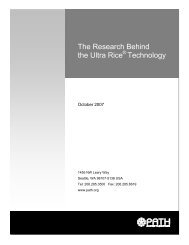Skills Checklist - Path
Skills Checklist - Path
Skills Checklist - Path
Create successful ePaper yourself
Turn your PDF publications into a flip-book with our unique Google optimized e-Paper software.
Immediate care of the newborn<br />
Practice checklist: AMTSL steps<br />
1. Place the baby on the mother’s abdomen. Thoroughly dry the baby<br />
while assessing the baby’s breathing.<br />
2. If the baby is not crying or breathing at least 30 times per minute<br />
within 30 seconds of birth, call for help and begin resuscitation.<br />
Otherwise, the baby should remain with the mother.<br />
3. Place the baby in skin-to-skin contact with the mother to maintain<br />
warmth, and cover the baby—including the head—with a clean, dry<br />
cloth while keeping the face unobstructed.<br />
4. If the mother is not able to hold the baby, ask her companion<br />
or an assistant to care for the baby.<br />
AMTSL step 1: Administration of a uterotonic drug<br />
Date<br />
Rating<br />
1. Palpate the uterus to make sure no other baby is present.<br />
2. If no other baby is present, administer a uterotonic drug (oxytocin<br />
10 IU IM is the uterotonic of choice) within one minute of<br />
delivery.2<br />
AMTSL step 2: Controlled cord traction<br />
1. Wait approximately 2–3 minutes after the birth, then place one<br />
clamp 4 cm from the baby’s abdomen.3<br />
2. Gently milk the cord towards the woman’s perineum and place a<br />
second clamp on the cord approximately 1 cm from the first clamp.<br />
3. Cut the cord using sterile scissors, covering the scissors with gauze<br />
to prevent blood spurts. Tie the cord after the provider performs<br />
AMTSL and completes initial care of the mother and baby.<br />
4. Place the palm of the other hand on the lower abdomen just above<br />
the woman’s pubic bone to assess for uterine contractions (do not<br />
massage the uterus before the placenta is delivered).<br />
5. Keep slight tension on the cord and await a strong uterine<br />
contraction (2–3 minutes).<br />
6. When there is a uterine contraction, apply countertraction to the<br />
uterus with the hand above the pubic bone (apply pressure on the<br />
uterus in an upward direction—towards the woman’s head).<br />
7. While applying countertraction to the uterus, apply firm, steady<br />
traction to the cord, pulling downward on the cord following the<br />
direction of the birth canal.<br />
8. If the placenta does not descend during 30 to 40 seconds of<br />
controlled cord traction and there are no signs of placental<br />
separation), stop controlled cord traction.<br />
2 If a woman has an IV, an option may be to give her 5 IU of oxytocin by slow IV push.<br />
3 This action allows red blood cells to transfer from the placenta to the baby, decreasing the<br />
incidence of infant anemia.<br />
IM = intramuscular; IV = intravenous
















